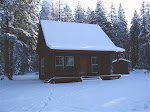So the gazebo in nearly done .... no wait ... this is just an example of what we want to build - we just started the project today! Geez!
Yesterday we determined where the center will be, then made an outline of the circumference. Then we marked where each post will go. I then dug the holes for two of the six footings.
The gazebo will be hexagon shaped and 16' across. A hexagon is of course a polygon with six sides and six vertices, but it is not to be confused with a sexagon, because a sexagon is a gazebo you have sex in ... so with any luck, this will be both a hexagon and a sexagon! But I digress ...
As in the example our gazebo will have six 16" x 16" concrete pillars going up to 3' above the ground. The pillars are going to be made from 8"x16" cinder blocks, sitting on 2' square' footings buried 18"-24" deep. We plan on covering those pillars with river rock. Log posts will sit on those, supporting log beams going around the perimeter of the gazebo. The rafters will also be log.
Our gazebo will not have a floor like most do. It will be natural ground that we'll cover with wood chips.
Next week, I'll start the concrete work using this nifty mini cement mixer I bought. It's capacity is 1.25 cf, which is enough for two 60# bags. I will mix one 80# bag at a time.

A real handy tool to have for this kind of project is a good quality spinning laser level. You can fairly easily determine the correct level for each footing and make them all the same. Unfortunately mine is a cheap one I bought at a Times employee auction. (Frank Blethen I want a refund!) You can barely see the laser more than 5' away in daylight, so this one is mostly for indoors. If I slow the spinner way down, and block the sun, and use a white stick to measure the height, it works ok.










